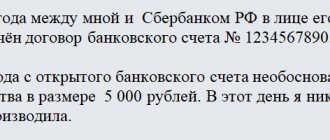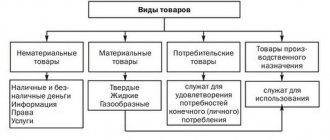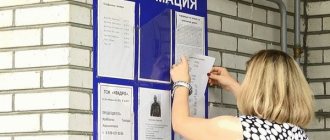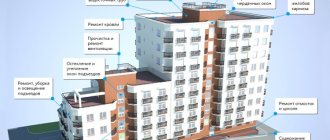MKD - what is it, according to the Housing Code of the Russian Federation
The Housing Code of the Russian Federation was adopted in 2004 in accordance with Federal Law No. 188-FZ of December 29, 2004.
MKD is an abbreviated name for an “apartment building”, which presupposes the presence of a collection of several residential premises (apartments) that have common premises for non-residential purposes or overlook a common area limited by a certain land plot.
For your information! A distinctive feature of an apartment building is the presence of several owners, which can be individuals and legal entities, as well as government agencies.
Issues related to the common property of owners in an apartment building, as well as questions about the general meeting, are reflected in Chapter 6 of the Housing Code of the Russian Federation “Common property of owners of premises in an apartment building. General meeting of such owners.”
Composition of common property in an apartment building
Difference from residential premises
The Regulations on the recognition of premises as residential contain the definition of an apartment building - this is a building containing elements of the common property of the owners.
It has a centralized heating system, dividing the house into floors and apartments. According to Article 16 of the Housing Code of the Russian Federation, a residential building is a building of a certain type, consisting of rooms, not apartments.
It may contain common areas necessary to satisfy residents’ household and other needs. The residential building has a separate entrance.
A plot of land may be attached to it. This definition of a residential building can be found in regulations.
The term MKD most often refers to a building where there is a collection of apartments, each of which has a separate entrance/exit, and has elements of common property of the owners.
MKD has several owners. Apartments can be owned by individuals, legal entities, and the state.
An agreement is concluded between homeowners and management companies on the basis of which services are provided.
Main characteristics of an apartment building
The main characteristics of an apartment building include the following parameters:
- location address;
- year of construction;
- number of the standard series or individual project on the basis of which construction was carried out;
- type of house and presence of built-in and attached premises;
- number of storeys;
- number of entrances;
- availability and number of elevators;
- number of residential and non-residential premises;
- total area with breakdown by type of available premises;
- cadastral number of the land plot on which the house is located;
- the area of the land plot included in the common property of the homeowners;
- parking area, if any, within the boundaries of the land plot;
- documents recognizing the house as unsafe, if any;
- energy efficiency class, in case of an energy audit of the building;
- additional information of a different nature.
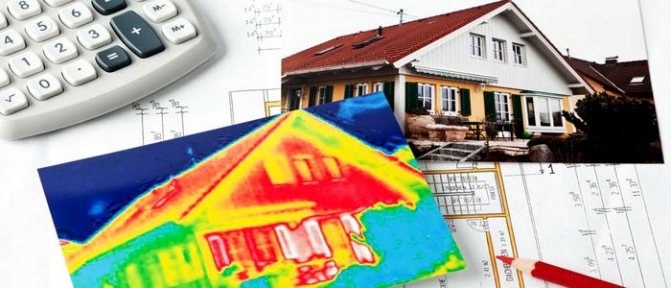
Conducting an energy audit of residential buildings is an optional activity, but the results of its implementation can significantly reduce the costs of general household needs associated with the use of energy resources
The main characteristics of the apartment building must be reflected in the Appendix to the Apartment Building Management Agreement. In addition to the above items, the specified Appendix must reflect information about the elements of improvement of the local area, as well as the boundaries of the operational responsibility of the Management Company and energy supply organizations.
Apartment building management
Management of the MKD and its life support systems is organized according to one of the following scenarios:
- If the building has no more than 30 apartments, the resident citizens have the right to manage it.
- If there are more premises, it is necessary to create a housing cooperative that will manage important processes.
- The management company is entrusted with looking after the house, which, in exchange for monthly deductions, monitors the condition of the local area and utility systems.
At the meeting of residents, issues are resolved about:
- Issuance of permission to use common property to unauthorized citizens.
- Repairing a building, adding extensions to it, changing the design.
- Ways to use a common plot of land for the benefit of all residents in the building.
- Transfer of powers to control the condition of apartment buildings to the local management company.
The meeting is not vested with any other powers, and controversial situations are resolved through the courts.
What is the difference between an apartment building and a private house?
The main difference between a private and apartment building is the object of ownership.
If in a private house, according to this criterion, the object of law is the house itself, then for MKD the object of law is individual apartments.
For your information! For a private house with several owners, the object of law, however, is the building itself, which in this case is in shared ownership.
The differences between an apartment building and a private building are determined by the following parameters:
- presence of owner (owners) of the property;
- the presence of common property that is in shared ownership;
- house management system and the presence of special bodies that carry out this process;
- the presence of components of a residential building under different forms of ownership.
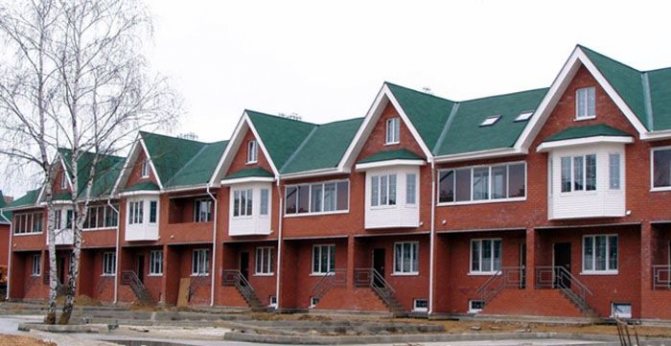
A town house looks like a private house, but... the owners have a common plot of land, then this type of building belongs to the category of apartment buildings
In simple terms, the differences can be formulated differently, namely:
- a residential building is divided into rooms, and apartment buildings into apartments;
- in an apartment building there is shared ownership, but in a private house there is no;
- management of a private house is carried out by the owner, and in an apartment building - by a meeting of rights holders of residential premises.
Features of an apartment building
The concept of how the structure of an apartment building is organized is given in the Housing Code of the Russian Federation. Features of an apartment building include:
- Each living room in the house is registered to a specific citizen. If the premises are empty and no one lives in it, this does not cancel the calculation of utility bills at basic rates.
- The apartment building is not maintained by the state. Responsibility for the repair of the building and common area, as well as the safety of internal communications, falls on the shoulders of the owners.
- Residents of an apartment building should open a personal fund, into which money will be allocated for the repair of water supply, heating and energy systems. They will begin to fail, and you should be prepared for this.
- Managing such a large property as an apartment building requires certain knowledge and skills to minimize damage during operation. If among the residents there is no specialist who understands how the building functions and what is needed to maintain it, entrust the care of the house and its vital systems to the management company. This will help avoid troubles when a single, well-established system suddenly fails, depriving residents of access to water, gas or electricity.
- The area surrounding an apartment building is common property. It is not allowed to organize a personal parking space or outbuilding without the approval of other residents.

What is the difference between an apartment building and a residential building?
Many citizens confuse apartment buildings with residential and private buildings, in which two or more families live at the same time. The differences between them are significant, and consist in the following details:
- A private house belongs to one person, and an apartment building belongs to several.
- A residential building consists of separate rooms used by residents at their own discretion. An apartment building consists of apartments owned by its own owner.
- Residents in a private house do not have common shares that determine the rights to joint property. Residents of apartment buildings have them.
- A private house is managed by the owner as he pleases, and apartment buildings are managed by a general meeting of residents or the management company.
Note! The differences are indicated for apartment buildings related to mixed ownership.
What is an apartment
An apartment is a separate room in an apartment building, from which there is access to common areas.
Consists of at least one room and household premises to satisfy the natural needs of residents who own the premises by right of ownership or rent them.
Apartments are:
- studio. They consist of one room, which is not fenced off from the kitchen. Separate bathroom;
- communal apartments. They have several rooms in which different families live. The kitchen and bathroom are shared;
- country apartments. These include buildings called townhouses and other buildings of similar layout.
Local area
According to the definition specified in the Housing Code of the Russian Federation, the adjacent territory of an apartment building includes:
- areas for sports;
- parking areas;
- children's playgrounds;
- pedestrian paths, sidewalks and pavements;
- entrances to the building;
- elements that provide the utility needs of the building - heating points, transformers and other buildings;
- areas of green space, lawn, flower beds.

The boundaries of the site are determined by the formula Snor= УхSk, where
Snor – local area;
U – specific measure of territory, calculated per square meter of housing;
Sk – area of the building allocated for apartments.
Typically, the boundaries of the local area end 3-6 meters from a residential building, but there are situations when the area is much larger in size.
Having registered the territory as their own, residents have the right to dispose of it at their own discretion, but are obliged to care for it at their own expense, repairing the road surface and other objects.
In the local area, residents are required to:
- organize cleaning, clearing key entrances to the building, the entrance to the entrance and a sign with the street name and building number;
- arrange parking spaces for all residents;
- arrange land plots for garbage cans and ensure that the area around them is not littered;
- carry out repair and construction work in the surrounding area, if necessary;
- monitor the condition of playgrounds.
Is a dormitory and a semi-detached house an apartment building?
A two-apartment house is classified as a multi-apartment building. This is clear from the definition, which states that a building, if there are 2 or more apartments and a shared plot, belongs to an apartment building.
With the hostel, everything is a little more complicated. To turn a former dormitory into an apartment building, you need to perform the following algorithm of actions:
- carry out an inventory of premises with further reconstruction;
- upon completion, it is necessary to re-register documents for the premises and change residential addresses.
Having fulfilled these conditions, residents have the right to rename their house into an apartment building. Otherwise, the apartments will continue to be classified as dormitories, albeit privatized ones.
Name of townhouse in property documents
According to the law, a townhouse does not belong to an apartment building and is considered a block-type residential building, and in some documents it is even listed as an apartment. Thus, the management company is not obliged to repair the facade and roof of the building at its own expense, but provides services only in public areas.
Note! The list of responsibilities assigned to the management company is indicated when drawing up a civil contract. The full list of responsibilities will depend on the agreements made between residents and utility services.
Is it possible to change the status of the premises?
Clause No. 1 of Article No. 36 of the Housing Code of the Russian Federation provides the following conditions for changing the status of the premises:
- Apartments that do not have common areas and are not connected by common communications actually belong to the category of residential buildings. Accordingly, the owner of the premises has the right to change its status by classifying this object as a residential building.
- Confirmation of the change in the status of the room and recognition of it as the property of a citizen is carried out through the court.
- To do this, a statement of claim is filed with the judicial authority at the location of the property.
- Certificates obtained from cadastral registration and after conducting a forensic construction examination are used as evidence.
After the court makes a positive decision, the plaintiff goes to the cadastral chamber to re-register the home.
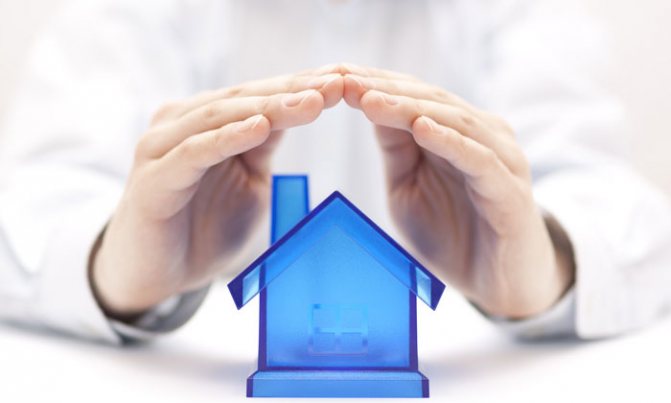
What premises are included in the apartment building?
In accordance with the Housing Code of the Russian Federation, premises located in common shared ownership in an apartment building include:
- Premises that are not parts of apartments and serve to service several real estate objects (staircases and landings, elevators, corridors and technical floors, basements, etc.).
- Premises serving for social and cultural events and general recreation areas for homeowners.
- Building structures (roof, walls, etc.), as well as engineering communications that serve to provide real estate with energy resources (water supply and sewerage networks, heat supply and electricity).
- A plot of land on which the apartment building and the adjacent area are located in accordance with the cadastral plan.
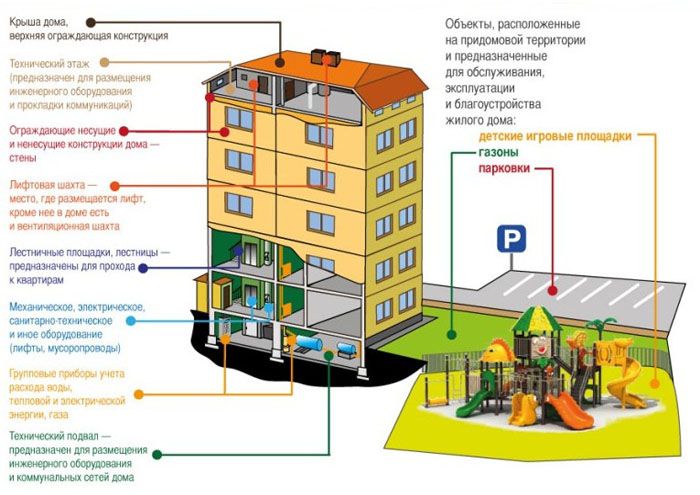
Scheme of distribution of common property of apartment buildings
What work is the responsibility of the management company?
A management company is an organization that the owners of real estate entrust with the management of their shared ownership property in accordance with the Trust Management Agreement.
Important! The responsibilities of management companies are regulated by the Housing Code of the Russian Federation, including articles No. 161 and 162.
The management company operates on the basis of a concluded Agreement with the property owners and performs the following work:
- ensures the safety of living in the serviced building in accordance with the Fire Safety Rules and the requirements of sanitary and epidemiological standards;
- provides owners with access to real estate objects that are in shared ownership;
- maintains engineering equipment and general house metering devices installed on utility lines in working condition;
- carries out repairs of common property;
- carries out general management of the activities of the MKD.
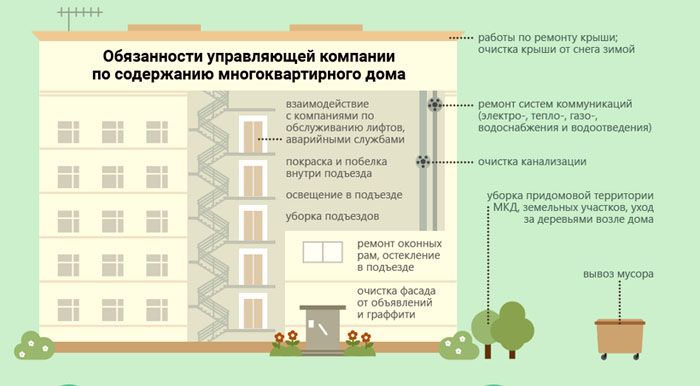
Responsibilities of the management company for the maintenance of apartment buildings
All work performed by the management company can be classified as follows:
- maintenance of common property and servicing the current needs of homeowners (garbage removal, energy supply, etc.);
- current and major repairs of common property.
How are tariffs for maintaining an apartment building determined?
Receiving income is the right of the management company (MC), and this is regulated by regulatory documents. In this regard, the organization that has entered into a Trust Management Agreement with homeowners sets tariffs for its services related to the maintenance of common property.
The list of such services and works is approved by a meeting of homeowners, and the amount of their cost is determined based on the current prices existing at the time of approval, as well as in accordance with the “Rules for the maintenance of common property in an apartment building,” approved by Decree of the Government of the Russian Federation of August 13, 2006 No. 491. Maintenance and repair costs are determined on the basis of an estimate drawn up for a specific property.
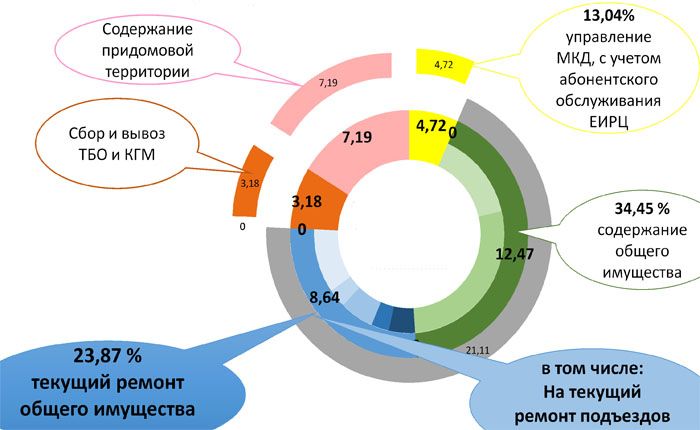
Structure of payment for services of the management company for the maintenance of apartment buildings
In the structure of tariffs billed by management companies to homeowners, the following are displayed in separate lines:
- costs of maintaining common property;
- maintenance of engineering equipment and communications;
- removal of household waste;
- maintenance of the local area.
How the tariff is formed
Citizens who own one or another type of property, for example an apartment in an apartment building, often wonder how tariffs for repairs are determined.
Tariffs are approved by all owners at a general meeting. In addition to paying for repairs and maintenance, apartment owners pay for housing if it was provided to them under a social tenancy agreement.
In this case, residents will not receive receipts to pay for major repairs - this responsibility falls on the municipality or state.
Tariffs are formed in the following main areas:
- Carrying out major repairs.
- Contributions for the maintenance of property located on common territory.
- Carrying out routine repairs of premises.
- Payment for renting housing under social rent conditions (if the apartment is not lived by the owner).
A separate item that is highlighted in receipts is garbage removal and routine repairs of engineering systems.
It may be a violation to add cleaning of the stairwell to the list, since this type of expense is already included in the fee for maintaining the premises. Double fees cannot be charged for the same service.
Video: check your payment
MSW - what is it in housing and communal services, and who is responsible for providing public services
The abbreviation MSW is an abbreviated name for “solid municipal waste,” which was put into circulation in 2021 and recorded in the Housing Code of the Russian Federation (Article 154) as a public service provided by management companies.
For your information! The concept of “solid household waste” is colloquial, and “solid municipal waste” is the correct name for household waste, recorded in regulatory documents (Federal Law No. 458-FZ of December 29, 2014).
The rules for handling MSW are regulated by Government Decree No. 1156 of November 12, 2016 “On the management of municipal solid waste and amendments to the Decree of the Government of the Russian Federation of August 25, 2008 N 641.” In addition to this document, the rules for handling MSW are regulated by the documents shown in the following figure.
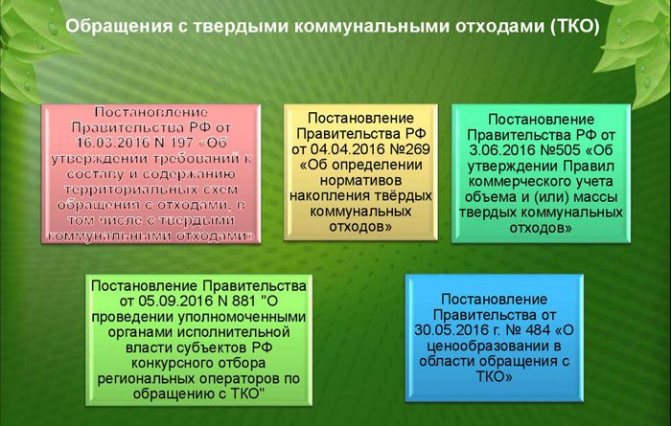
Documents regulating the rules for handling MSW
In the receipt issued by the management company to the homeowner for utilities, MSW is reflected on a separate line. The amount to be paid depends on the accepted method of calculation, which determines the unit of measurement for the provision of this service: the number of registered residents in the apartment or the size of the living space.
Important! The tariff for the collection and removal of MSW must take into account the type of collection of this waste: separate by category or general.
What is an apartment building council?
The council of an apartment building is an elected body that is not a legal entity and is elected by a general meeting of homeowners. The responsibilities and functions of the MKD council are determined by the RF Housing Code; they can be formulated as follows:
- Monitoring the activities of the management company.
- Coordination of the activities of the management company and identification of priority activities required for implementation.
- Review and approval of estimates for major and current repairs.
- Studying and drawing up proposals for improving service by energy supply and other organizations providing services for the maintenance of apartment buildings.
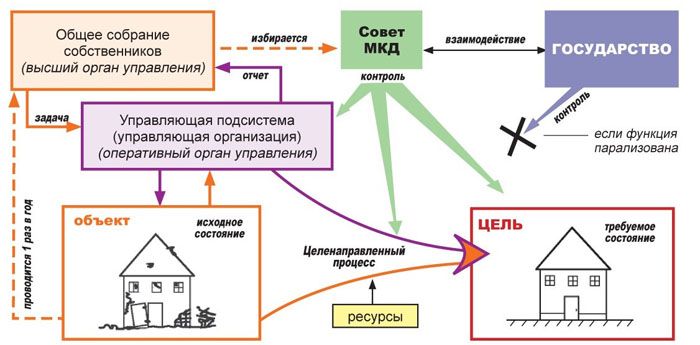
The role of the MKD council in monitoring the work of the management company
For your information! The council of an apartment building must draw up a plan for its work for the year, after which it reports on the work done at the general meeting of homeowners.
A chairman is elected from among the members of the council of the apartment building, who is vested with certain powers, expressed in his rights and responsibilities.
Rights of the chairman of the MKD:
- signs certificates of work performed at MKD facilities;
- signs reports of violations identified in the work of the management company and other organizations providing MKD services;
- resolves issues with the administration of the region where the MKD is located in case of violations of the activities of the management company.
Responsibilities of the Chairman of the MKD:
- manages the activities of the MKD council;
- negotiates with the management company on issues of cooperation and provision of services;
- acts on behalf of homeowners in various administrative bodies when drawing up the appropriate power of attorney.
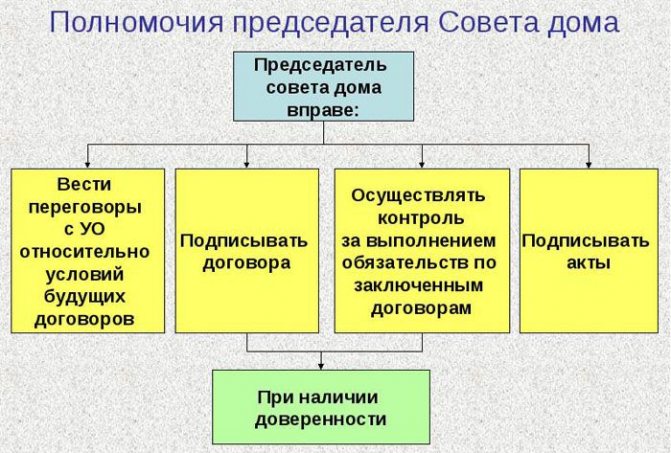
Powers of the chairman of the MKD
All issues related to the activities of the management company, the board and the chairman of the MKD can be resolved by knowing the relevant regulatory documents, as well as having experience in resolving legal issues. Therefore, if difficulties and problems arise in this area of life of a modern person, it is best to seek help from a qualified lawyer working in the housing and communal services sector.
